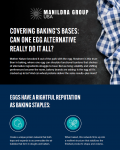Why are gluten-free products more expensive?

Gluten-free products are very important to a significant minority of consumers. According to the European Food Safety Authority (EFSA), around 0.7% of the EU’s population have coeliac disease. In the UK, around 1% have the condition, according to the charity Coeliac UK.
Coeliac disease is a condition caused by an immune reaction to gluten, as well as proteins in foods such as wheat, barley and rye. Symptoms typically include stomach ache, vomiting, diarrhoea, iron deficiency (anaemia) and infertility.
Gluten-free products are, thus, very important to people with this condition. Despite years of apparent stagnation, the gluten-free aisle is now booming, and sales of gluten-free products are steadily rising. The market is expected to double to $14bn by 2032 (its current value is $6.7bn).
Nevertheless, things are not easy for many consumers of gluten-free products. In the UK, for example, people on a gluten-free diet face cost pressures that those who consume gluten do not.
How expensive is gluten-free food?
According to the organisation UK Debt Expert, UK shoppers on a gluten-free diet are paying on average 37% more than those on a diet with gluten products. The research revealed that the average person is spending an extra £13.55 each week on their weekly shop.
The company compared the prices of 25 weekly shops across four major UK supermarket retailers.
Despite being more expensive, gluten-free products were often found to be smaller. For example, while a 600g loaf of bread at Sainsbury’s costs £1.65, according to the research, a 400g free-from loaf costs £3.70. An 195g garlic bread cost £1, while its 190g gluten-free equivalent cost £2.
Despite the aforementioned increase in demand, the research found that the free-from aisle in supermarkets (which also included dairy and nut-free products) were still significantly smaller than the selections for those without dietary requirements.
Gluten-free wheat flour
While many gluten-free breads are made with alternative flours, there is another option: gluten-free wheat flour. Spanish start-up Bread Free has produced gluten-free wheat flour, using biotechnology to remove the gluten.
Earlier this year, Coeliac UK researched the cost of gluten-free products in the UK. It found that a gluten-free loaf of bread is, on average, 4.5 times more expensive than a gluten-containing loaf, and the cheapest gluten-containing loaf is 6.1 times cheaper than the cheapest gluten-free loaf.
Furthermore, 4% of people surveyed in the report were actively eating gluten out of cost concerns, despite the fact that it had the potential to damage their health.
Why is gluten-free food so expensive?
The reasons behind the cost of gluten-free food is closely linked to the resources needed to produce it. More rarefied flours, such as almond and coconut flour, make up these products.
Allergen contamination cannot be ruled out
You would think that the label ‘free-from’ is a fairly conclusive guarantee of safety from allergens. However, according to Jennifer Elegbede, global food and health applications manager at ingredients supplier Lycored, this is not the case. If the food chain, she told FoodNavigator, is not vertically integrated within a company, you can never know for sure that products are free of allergens.
“While demand for gluten-free alternatives has increased over recent years, there’s still less demand for these specific products compared to their ‘standard’ alternatives so manufacturers and retailers can’t utilise the same economies of scale,” Maxine McCreadie, personal finance expert at UK Debt Expert, told FoodNavigator.
Economies of scale refers to the economic theory which posits that the greater quantity in which something is produced, the cheaper it will be to produce per item. A niche product such as gluten-free, therefore, has evident disadvantages.
“This issue worsens with the rising cost of living. If the government can address supply chain problems and support local gluten-free production, it could help reduce costs. Additionally, supermarkets need to understand the financial challenges their shoppers with intolerances face. Everyone should be able to afford their dietary needs without a significant financial burden,” McCreadie told us.
According to the Coeliac UK report, the costs involved in gluten testing, plus the increased quantity of ingredients needed and the segregation of the supply chain, also played a role.













